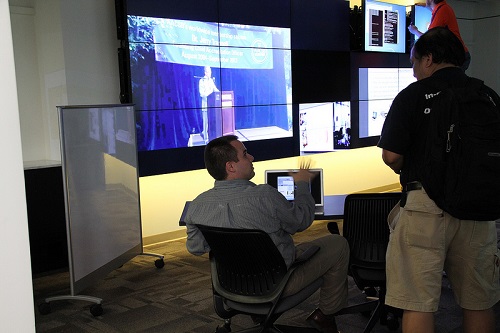BIG DATA
Supercomputer powers Clemson's classrooms of the future

The classroom of the future. A game changer. Technology showcase. These are all terms used to describe the new Edgar Brown Digital Resources Laboratoryin Clemson University’s R.M. Cooper Library.
The newly renovated space resulted from a growing partnership between Clemson Computing and Information Technology (CCIT) and the libraries to create a living laboratory space for use by faculty and students across campus.
In keeping with the innovative mindset of the room’s namesake, the late Edgar Brown, and to honor the memory of the former senator and Clemson trustee, the Brown Room has been transformed into a state-of-the-art environment to be used for learning and research enabled by technology.
The new facility will have a grand opening from 2 to 3 p.m. on Thursday.
The Edgar Brown Room first opened in 1971 as an exhibit in Brown’s memory. The room previously displayed Brown’s photographs, certificates, hat rack, desk, chairs and conference table. Now, however, the artifacts have been moved to the Strom Thurmond Institute’s Special Collections Library to keep up with the evolving technological needs of Clemson’s students and faculty.
Clemson University Libraries partnered with CCIT and Dell, with support from the National Science Foundation, to create the new space over the summer.
A few of its key features include a visualization wall of 15 46-inch high-definition displays, a 16-node supercomputational cluster, laptops for 16 students with software customization available, network and video connections in the floor, a high-definition video-conferencing system and four projectors, one of which creates a holographic-type image.
The technology found in this room is unparalleled in any classroom or laboratory on campus, and is in a central location in the Cooper Library to be a showcase to both current and potential students on Clemson’s intellectual capabilities.
While technology-oriented, the laboratory is intended for use by all academic departments.
“So many of the higher-tech rooms are within departments,” explained Dean of Libraries Kay Wall. “Our facility is available for any faculty to use.”
Jan Holmevik, associate professor of English, plans to use the laboratory next semester for his seminar “The Walking Dead: Trans Media Fiction and Storytelling,” which examines the literary trends present in “The Walking Dead” across different types of media, including comic books, television series, novels and video games. The class will use all of the room’s available projection and multimedia display technologies so that students can work with multiple media sources at once. Students also will produce videos and use social media as a part of the course.
“In the past we would sit in a classroom and talk about a text, but English is evolving,” said Holmevik. “We are inventing the new English department.”
The room is available to all faculty, who must propose their plan of use for the lab. This enables courses and group collaborations from across campus to conduct their courses or research in a world-class environment enabled by innovative technologies, such as network connectivity that enables high-speed transfers of large data sets to users of the room.
“The only criteria we have is that the technology is utilized,” said intern project manager Reggie Coachman.
The room’s technology, however, serves as a first step in advancing the technological capabilities of Clemson’s campus.
“This is a prototype for lots of other technological applications throughout Clemson’s system,” said Wall.
